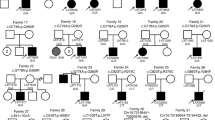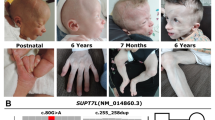Abstract
Neural tube defects (NTDs), which include spina bifida and anencephaly, are the second most common form of human structural congenital malformations. While it is well established that SHROOM3 plays a pivotal role in the complex morphogenetic processes involved in neural tube closure (NTC), the underlying genetic contributions of SHROOM gene family members in the etiology of human NTDs remain poorly understood. Herein, we systematically investigated the mutation patterns of SHROOM1-4 in a Chinese population composed of 343 NTD cases and 206 controls, using targeted next-generation sequencing. Functional variants were further confirmed by western blot and the mammalian two-hybrid assays. Loss of function (LoF) variants were identified in SHROOM3. We observed 1.56 times as many rare [minor allele frequency (MAF) < 0.01] coding variants (p = 2.9 × 10−3) in SHROOM genes, and 4.5 times as many rare D-Mis (deleterious missense) variants in SHROOM2 genes in the NTD cases compared with the controls. D-Mis variants of SHROOM2 (p.A1331S; p.R1557H) were confirmed by Sanger sequencing, and these variants were determined to have profound effects on gene function that disrupted their binding with ROCK1 in vitro. These findings provide genetic and molecular insights into the effects of rare damaging variants in SHROOM2, indicating that such variants of SHROOM2 might contribute to the risk of human NTDs. This research enhances our understanding of the genetic contribution of the SHROOM gene family to the etiology of human NTDs.


Similar content being viewed by others
References
Adzhubei IA, Schmidt S, Peshkin L, Ramensky VE, Gerasimova A, Bork P, Kondrashov AS, Sunyaev SR (2010) A method and server for predicting damaging missense mutations. Nat Methods 7:248–249. https://doi.org/10.1038/nmeth0410-248
Allache R, De Marco P, Merello E, Capra V, Kibar Z (2012) Role of the planar cell polarity gene CELSR1 in neural tube defects and caudal agenesis. Birth Defects Res A Clin Mol Teratol 94:176–181. https://doi.org/10.1002/bdra.23002
Bosoi CM, Capra V, Allache R, Trinh VQ, De Marco P, Merello E, Drapeau P, Bassuk AG, Kibar Z (2011) Identification and characterization of novel rare mutations in the planar cell polarity gene PRICKLE1 in human neural tube defects. Hum Mutat 32:1371–1375. https://doi.org/10.1002/humu.21589
Copp AJ, Greene ND (2010) Genetics and development of neural tube defects. J Pathol 220:217–230. https://doi.org/10.1002/path.2643
Curtin JA, Quint E, Tsipouri V, Arkell RM, Cattanach B, Copp AJ, Henderson DJ, Spurr N, Stanier P, Fisher EM, Nolan PM, Steel KP, Brown SD, Gray IC, Murdoch JN (2003) Mutation of Celsr1 disrupts planar polarity of inner ear hair cells and causes severe neural tube defects in the mouse. Curr Biol 13:1129–1133
Das D, Zalewski JK, Mohan S, Plageman TF, VanDemark AP, Hildebrand JD (2014) The interaction between Shroom3 and Rho-kinase is required for neural tube morphogenesis in mice. Biol Open 3:850–860. https://doi.org/10.1242/bio.20147450
De Marco P, Merello E, Rossi A, Piatelli G, Cama A, Kibar Z, Capra V (2012) FZD6 is a novel gene for human neural tube defects. Hum Mutat 33:384–390. https://doi.org/10.1002/humu.21643
Ernst S, Liu K, Agarwala S, Moratscheck N, Avci ME, Dalle Nogare D, Chitnis AB, Ronneberger O, Lecaudey V (2012) Shroom3 is required downstream of FGF signalling to mediate proneuromast assembly in zebrafish. Development 139:4571–4581. https://doi.org/10.1242/dev.083253
Etheridge SL, Ray S, Li S, Hamblet NS, Lijam N, Tsang M, Greer J, Kardos N, Wang J, Sussman DJ, Chen P, Wynshaw-Boris A (2008) Murine dishevelled 3 functions in redundant pathways with dishevelled 1 and 2 in normal cardiac outflow tract, cochlea, and neural tube development. PLoS Genet 4:e1000259. https://doi.org/10.1371/journal.pgen.1000259
Greene ND, Gerrelli D, Van Straaten HW, Copp AJ (1998) Abnormalities of floor plate, notochord and somite differentiation in the loop-tail (Lp) mouse: a model of severe neural tube defects. Mech Dev 73:59–72
Haigo SL, Hildebrand JD, Harland RM, Wallingford JB (2003) Shroom induces apical constriction and is required for hingepoint formation during neural tube closure. Curr Biol 13:2125–2137
Harris MJ, Juriloff DM (2010) An update to the list of mouse mutants with neural tube closure defects and advances toward a complete genetic perspective of neural tube closure. Birth Defects Res A Clin Mol Teratol 88:653–669. https://doi.org/10.1002/bdra.20676
Hildebrand JD (2005) Shroom regulates epithelial cell shape via the apical positioning of an actomyosin network. J Cell Sci 118:5191–5203. https://doi.org/10.1242/jcs.02626
Hildebrand JD, Soriano P (1999) Shroom, a PDZ domain-containing actin-binding protein, is required for neural tube morphogenesis in mice. Cell 99:485–497
Homsy J, Zaidi S, Shen Y, Ware JS, Samocha KE, Karczewski KJ, DePalma SR, McKean D, Wakimoto H, Gorham J, Jin SC, Deanfield J, Giardini A, Porter GA Jr, Kim R, Bilguvar K, Lopez-Giraldez F, Tikhonova I, Mane S, Romano-Adesman A, Qi H, Vardarajan B, Ma L, Daly M, Roberts AE, Russell MW, Mital S, Newburger JW, Gaynor JW, Breitbart RE, Iossifov I, Ronemus M, Sanders SJ, Kaltman JR, Seidman JG, Brueckner M, Gelb BD, Goldmuntz E, Lifton RP, Seidman CE, Chung WK (2015) De novo mutations in congenital heart disease with neurodevelopmental and other congenital anomalies. Science 350:1262–1266. https://doi.org/10.1126/science.aac9396
Kibar Z, Torban E, McDearmid JR, Reynolds A, Berghout J, Mathieu M, Kirillova I, De Marco P, Merello E, Hayes JM, Wallingford JB, Drapeau P, Capra V, Gros P (2007) Mutations in VANGL1 associated with neural-tube defects. N Engl J Med 356:1432–1437. https://doi.org/10.1056/NEJMoa060651
Kinoshita N, Sasai N, Misaki K, Yonemura S (2008) Apical accumulation of Rho in the neural plate is important for neural plate cell shape change and neural tube formation. Mol Biol Cell 19:2289–2299. https://doi.org/10.1091/mbc.E07-12-1286
Kumar P, Henikoff S, Ng PC (2009) Predicting the effects of coding non-synonymous variants on protein function using the SIFT algorithm. Nat Protoc 4:1073–1081. https://doi.org/10.1038/nprot.2009.86
Lei YP, Zhang T, Li H, Wu BL, Jin L, Wang HY (2010) VANGL2 mutations in human cranial neural-tube defects. N Engl J Med 362:2232–2235. https://doi.org/10.1056/NEJMc0910820
Lemay P, Guyot MC, Tremblay E, Dionne-Laporte A, Spiegelman D, Henrion E, Diallo O, De Marco P, Merello E, Massicotte C, Desilets V, Michaud JL, Rouleau GA, Capra V, Kibar Z (2015) Loss-of-function de novo mutations play an important role in severe human neural tube defects. J Med Genet 52:493–497. https://doi.org/10.1136/jmedgenet-2015-103027
Li Z, Ren A, Zhang L, Ye R, Li S, Zheng J, Hong S, Wang T, Li Z (2006) Extremely high prevalence of neural tube defects in a 4-county area in Shanxi Province, China. Birth Defects Res A Clin Mol Teratol 76:237–240. https://doi.org/10.1002/bdra.20248
McGreevy EM, Vijayraghavan D, Davidson LA, Hildebrand JD (2015) Shroom3 functions downstream of planar cell polarity to regulate myosin II distribution and cellular organization during neural tube closure. Biol Open 4:186–196. https://doi.org/10.1242/bio.20149589
McLaren W, Pritchard B, Rios D, Chen Y, Flicek P, Cunningham F (2010) Deriving the consequences of genomic variants with the Ensembl API and SNP Effect Predictor. Bioinformatics 26:2069–2070. https://doi.org/10.1093/bioinformatics/btq330
Murdoch JN, Damrau C, Paudyal A, Bogani D, Wells S, Greene ND, Stanier P, Copp AJ (2014) Genetic interactions between planar cell polarity genes cause diverse neural tube defects in mice. Dis Model Mech 7:1153–1163. https://doi.org/10.1242/dmm.016758
Nishimura T, Takeichi M (2008) Shroom3-mediated recruitment of Rho kinases to the apical cell junctions regulates epithelial and neuroepithelial planar remodeling. Development 135:1493–1502. https://doi.org/10.1242/dev.019646
Nishimura T, Honda H, Takeichi M (2012) Planar cell polarity links axes of spatial dynamics in neural-tube closure. Cell 149:1084–1097. https://doi.org/10.1016/j.cell.2012.04.021
Qiao X, Liu Y, Li P, Chen Z, Li H, Yang X, Finnell RH, Yang Z, Zhang T, Qiao B, Zheng Y, Wang H (2016) Genetic analysis of rare coding mutations in CELSR1-3 in Chinese congenital heart and neural tube defects. Clin Sci (Lond). https://doi.org/10.1042/CS20160686
Rath N, Olson MF (2012) Rho-associated kinases in tumorigenesis: re-considering ROCK inhibition for cancer therapy. EMBO Rep 13:900–908. https://doi.org/10.1038/embor.2012.127
Robinson A, Escuin S, Doudney K, Vekemans M, Stevenson RE, Greene ND, Copp AJ, Stanier P (2012) Mutations in the planar cell polarity genes CELSR1 and SCRIB are associated with the severe neural tube defect craniorachischisis. Hum Mutat 33:440–447. https://doi.org/10.1002/humu.21662
Roszko I, Sawada A, Solnica-Krezel L (2009) Regulation of convergence and extension movements during vertebrate gastrulation by the Wnt/PCP pathway. Semin Cell Dev Biol 20:986–997. https://doi.org/10.1016/j.semcdb.2009.09.004
Seo JH, Zilber Y, Babayeva S, Liu J, Kyriakopoulos P, De Marco P, Merello E, Capra V, Gros P, Torban E (2015) Mutations in the planar cell polarity gene, Fuzzy, are associated with neural tube defects in humans. Hum Mol Genet 24:3893. https://doi.org/10.1093/hmg/ddv131
Shi Y, Ding Y, Lei YP, Yang XY, Xie GM, Wen J, Cai CQ, Li H, Chen Y, Zhang T, Wu BL, Jin L, Chen YG, Wang HY (2012) Identification of novel rare mutations of DACT1 in human neural tube defects. Hum Mutat 33:1450–1455. https://doi.org/10.1002/humu.22121
Sim NL, Kumar P, Hu J, Henikoff S, Schneider G, Ng PC (2012) SIFT web server: predicting effects of amino acid substitutions on proteins. Nucleic Acids Res 40:W452–W457. https://doi.org/10.1093/nar/gks539
Timberlake AT, Choi J, Zaidi S, Lu Q, Nelson-Williams C, Brooks ED, Bilguvar K, Tikhonova I, Mane S, Yang JF, Sawh-Martinez R, Persing S, Zellner EG, Loring E, Chuang C, Galm A, Hashim PW, Steinbacher DM, DiLuna ML, Duncan CC, Pelphrey KA, Zhao H, Persing JA, Lifton RP (2016) Two locus inheritance of non-syndromic midline craniosynostosis via rare SMAD6 and common BMP2 alleles. Elife 5:e20125. https://doi.org/10.7554/eLife.20125
Wallingford JB (2005) Neural tube closure and neural tube defects: studies in animal models reveal known knowns and known unknowns. Am J Med Genet C Semin Med Genet 135C:59–68. https://doi.org/10.1002/ajmg.c.30054
Wallingford JB, Niswander LA, Shaw GM, Finnell RH (2013) The continuing challenge of understanding, preventing, and treating neural tube defects. Science 339:1222002. https://doi.org/10.1126/science.1222002
Wang Y, Guo N, Nathans J (2006) The role of Frizzled3 and Frizzled6 in neural tube closure and in the planar polarity of inner-ear sensory hair cells. J Neurosci 26:2147–2156. https://doi.org/10.1523/JNEUROSCI.4698-05.2005
Yang XY, Zhou XY, Wang QQ, Li H, Chen Y, Lei YP, Ma XH, Kong P, Shi Y, Jin L, Zhang T, Wang HY (2013) Mutations in the COPII vesicle component gene SEC24B are associated with human neural tube defects. Hum Mutat 34:1094–1101. https://doi.org/10.1002/humu.22338
Zalewski JK, Mo JH, Heber S, Heroux A, Gardner RG, Hildebrand JD, VanDemark AP (2016) Structure of the Shroom–Rho kinase complex reveals a binding interface with monomeric shroom that regulates cell morphology and stimulates kinase activity. J Biol Chem 291:25364–25374. https://doi.org/10.1074/jbc.M116.738559
Acknowledgements
This work was supported by Grants from the 973 Program (2013CB945403), the National Natural Science Foundation of China (81430005, 31521003), National key research and development program (2016YFC1000502), and the Commission for Science and Technology of Shanghai Municipality (17JC1400902) to H. Wang. Finnell was supported by Changjiang Scholar award.
Author information
Authors and Affiliations
Contributions
HW and ZC directed and designed the study. ZC performed statistical and bioinformatics analysis. LK performed functional validation. HW, ZC, RF, and LK prepared the manuscript; all authors reviewed the manuscript.
Corresponding author
Ethics declarations
Conflict of interest
The author declares no competing financial interests.
Electronic supplementary material
Below is the link to the electronic supplementary material.
Rights and permissions
About this article
Cite this article
Chen, Z., Kuang, L., Finnell, R.H. et al. Genetic and functional analysis of SHROOM1-4 in a Chinese neural tube defect cohort. Hum Genet 137, 195–202 (2018). https://doi.org/10.1007/s00439-017-1864-x
Received:
Accepted:
Published:
Issue Date:
DOI: https://doi.org/10.1007/s00439-017-1864-x




